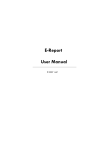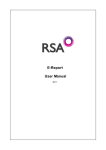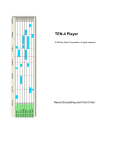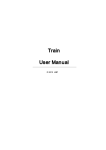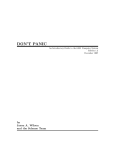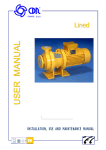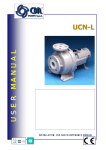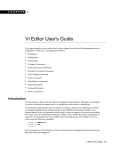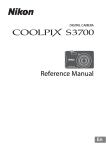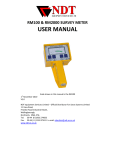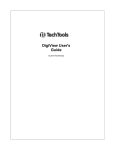Download Train User Manual
Transcript
Train
User Manual
© 2013 LMP
All rights reserved. No parts of this work may be reproduced in any form or by any means graphic, electronic, or mechanical, including photocopying, recording, taping, or information
storage and retrieval systems - without the written permission of the publisher.
Products that are referred to in this document may be either trademarks and/or registered
trademarks of the respective owners. The publisher and the author make no claim to these
trademarks.
While every precaution has been taken in the preparation of this document, the publisher and the
author assume no responsibility for errors or omissions, or for damages resulting from the use of
information contained in this document or from the use of programs and source code that may
accompany it. In no event shall the publisher and the author be liable for any loss of profit or any
other commercial damage caused or alleged to have been caused directly or indirectly by this
document.
The text of this manual is subject to change without notice. The current version of the manual is
available from the Train documentation page: www.lmp.co.uk/train_docs.html
© 2013 LMP
Contents
I
Table of Contents
Part I Getting Started
3
1 Logging
...................................................................................................................................
On
3
2 Exiting ...................................................................................................................................
Train
3
3 Screen...................................................................................................................................
Layout
4
4 Recent ...................................................................................................................................
Reports
4
Part II Reports
10
Part III Alert
14
1 Overdue
...................................................................................................................................
Inspections
16
2 Repairs
................................................................................................................................... 17
3 Not Available
................................................................................................................................... 18
Part IV History
20
Part V Dates
24
Part VI Graph
28
1 Graph...................................................................................................................................
options
30
Part VII Search
32
Part VIII Locations
38
Index
© 2013 LMP
45
I
Getting Started
Part
I
Getting Started
1
Getting Started
1.1
Logging On
3
Double-click on the Train icon to access the Logon screen.
Train requires a Username and Password to be entered before access is allowed. This is to:
ensure that the correct data is made available to individual users,
protect the integrity of data stored, and
ensure that the correct security settings are applied to prevent misuse of the system.
Logon Screen
1.
2.
3.
Enter the login name and password (as provided by LMP or the System Administrator) into the
appropriate boxes.
Where a secure internet connection is required, place a tick in the "Use secure connection" box.
Click Login.
NOTE: Usernames and passwords within Train are not case sensitive – "M.BROWN", "M.Brown", and
"m.brown" are all valid. However, the use of punctuation, or spaces between characters, is relevant and
where applicable should be maintained.
1.2
Exiting Train
To exit Train and close the program, click the cross in the top right hand corner of the screen.
© 2013 LMP
4
1.3
Train
Screen Layout
All screens within Train share a similar format:
Menu Bar - this consists of File, View, Toolbars, Utilities and Help menu options and remains static
throughout Train.
Tool Bar - the main navigational point within Train. Click on a Tool Bar option to move to that screen.
Data Area - information requested from Train is displayed in the Data Area. Data displayed, and actions
that can be carried out on the data, vary from screen to screen.
1.4
Recent Reports
After logging in, Train will open onto the "HSB Today" screen:
© 2013 LMP
Getting Started
5
The Today screen is Train's equivalent of an email inbox. As reports are received, summary details are
displayed on the Today screen.
To read a report, double click on the appropriate summary details:
Once the report has been read, click
to return to the Recent Reports screen.
By default, the Today screen displays a list of reports received within the last 14 days. This view may be
altered to show items rather than reports, and the time-frame can be changed to 1, 7, 14, 21, 28 or 91
days. To choose to view items or to change the time-frame, click on Reports or 14 and select the required
option from the subsequent drop-down list.
Alert details
Clicking on <Click here to refresh Alert screen> will display the Alert screen. If the Recent Reports page is
reselected, the view will alter:
© 2013 LMP
6
Train
Clicking on any of the links will switch the view to the Alert screen and display the relevant tab.
Report Listing
The Report Listing offers a number of options. Right-click in the Data Area to view the options menu:
Save List to file
To save the currently displayed report listing:
1.
2.
3.
4.
Right-click in the Data Area of the screen.
Select "Save List to file" from the subsequent menu.
Navigate to the location in which the file is to be saved, select the appropriate file type from the dropdown list and set a filename.
Click Save.
Edit Displayed Data
Edit Displayed Data allows the customisation of information presented on the report listing.
To add fields to a view:
1.
2.
3.
Right-click in the Data Area.
Select "Edit Displayed Data" from the subsequent menu.
The Customization box will open:
4.
5.
Drag the required field name from the Customization box to the header bar on the report list.
Repeat as required and then close the Customization box (click the cross in the top right-hand corner) to
refresh the view of the data.
To remove fields from a view:
1.
2.
3.
4.
5.
Right-click in the Data Area.
Select "Edit Displayed Data" from the subsequent menu.
The Customization box will open.
Drag the field name to be removed away from its position. As soon as a cross appears on the field name,
release the mouse button. The field will be removed from the screen and will instead be listed in the
Customization box.
Repeat as required and then close the Customization box (click the cross in the top right-hand corner).
© 2013 LMP
Getting Started
7
Email list to...
To email the currently displayed report listing:
1.
2.
3.
4.
5.
Right-click in the Data Area.
Select "Email list to...." from the subsequent menu.
Input the email address of the recipient(s) in the blank email which opens.
Add a subject line and any message.
Click Send Message. The report listing will be sent as an attachment to the email.
Email multiple reports
To email multiple reports, the option to send email using the local copy of Outlook must have been enabled.
See Email Options for information on applying this setting.
1.
Select the required reports:
To select reports distributed throughout the listing, select the first report and then hold down the
Control key and click on the other required reports. (NOTE: Selected reports will be highlighted in
blue).
To select reports adjacent to one another, click on the first report, hold down the Shift key and
select the last of the group. (NOTE: Selected reports will be highlighted in blue).
2.
3.
4.
5.
Click the Utilities tab on the Menu Bar and then click
Email Batch on the Tool Bar.
Input the email address of the recipient(s) in the blank email which opens.
Add a subject line and any necessary message.
Click Send. The reports will be sent as attachments to the email.
Printing multiple reports
1.
2.
3.
Select the required reports:
To select reports distributed throughout the listing, select the first report and then hold down the
Control key and click on the other required reports. (NOTE: Selected reports will be highlighted in
blue).
To select reports adjacent to one another, click on the first report, hold down the Shift key and
select the last of the group. (NOTE: Selected reports will be highlighted in blue).
Click the Utilities tab on the Menu Bar and then click {icon} Batch Print on the Tool Bar.
The standard Windows print control box will then open offering a choice of printer. Make any necessary
changes and then click OK.
Printing report lists
1.
2.
© 2013 LMP
Select {icon} Print from either the Utilities tab or in the window title area.
The standard Windows print control box will open offering a choice of printer. Make any necessary
changes and click OK.
Reports
Part
II
10
2
Train
Reports
To view a report, double-click on the appropriate report details in the data area of the screen. The selected
report will be displayed in a similar format to a paper version:
Normally, the entire report will not fit onto the screen, so a scroll bar at the right hand edge allows a view of
the whole report to be obtained through scrolling up or down.
User Comments
Uniquely, electronic reporting offers a User Comments section. This enables the tracking of actions performed
as a result of the report, and also allows the action and overdue reminders for a particular report to be
cleared:
To record a comment:
© 2013 LMP
Reports
11
Field Name
Action
Result
Remove from
Overdue List
Single click
Once selected, the current report will no longer appear on the "Overdue
Inspection" list of the Alert screen.
Remove Actions
Reminder
Single click
Once selected the current report will no longer appear on the
"Outstanding Defects" list of the Alert screen.
User Status
Pick list
Choose from a list of standard responses. Information input here will be
stored against the current report. "User Status" can be used as a criterion
on the Search screen.
User Comments
Text entry
Click into the box under "User Comments" and input the required text.
Information input here will be stored against the current report and,
where selected, will appear in subsequent printouts.
NOTE: There is no 'Save' button in Train. Changes are saved automatically on exit from the screen.
Printing a report
Select {icon} Print from either the Utilities tab or in the window title area.
The standard Windows print control box will open offering a choice of printer. If the selected report is too
large to fit onto a single sheet of paper, a page break will automatically be inserted at an appropriate point.
Exporting a report
A report may be saved to a file or emailed from Train:
To save a report:
1.
2.
3.
4.
Right-click in the Data Area of the report.
Select "Save As..." from the subsequent menu.
Navigate to the location in which the report is to be saved, select the required file type from the
drop-down list and set a filename.
Click Save.
To email a report:
1.
2.
3.
4.
5.
© 2013 LMP
Right-click in the Data Area of the report.
Select "e-mail report to..." from the subsequent menu.
Input the email address of the recipient(s) in the blank email which opens.
Add a subject line and any necessary message.
Click Send Message. Depending on the Email options which have been set, the report will be sent as
either an attachment to the email or as the body of the email message.
Alert
Part
III
14
3
Train
Alert
The Alert screen is accessed either via the
icon or by selecting the <Click here to refresh Alert screen>
on the "Recent Reports" page. It offers an overview, via three tabs, of reports of inspections which:
have overdue reports listed against them and require a more recent inspection report (Overdue
Inspections)
require remedial action by the owner/user of the plant (Outstanding Repairs)
could not have an examination carried out (Not Availables)
By default, the Alert screen opens on the Overdue Inspections tab.
Report Listing
The Report Listing offers a number of options. Right-click in the Data Area to view the options menu:
Clear All Items/Clear Selected Items
Depending on the currently selected tab, selecting the Clear All Items option and clicking the subsequent
Confirm button will clear all overdue inspections, items marked as not available or any defects. Selecting
specific items and clicking Clear Selected items will clear these.
Delete Report
NOTE: This option has no effect. Reports cannot be deleted from Train.
Save List to file
© 2013 LMP
Alert
15
To save the currently displayed report listing:
1.
2.
3.
4.
Right-click in the Data Area of the screen.
Select "Save List to file" from the subsequent menu.
Navigate to the location in which the file is to be saved, select the appropriate file type from the dropdown list and set a filename.
Click Save.
Edit Displayed Data
Edit Displayed Data allows the customisation of information presented on the report listing.
To add fields to a view:
1.
2.
3.
Right-click in the Data Area.
Select "Edit Displayed Data" from the subsequent menu.
The Customization box will open:
4.
5.
Drag the required field name from the Customization box to the header bar on the report list.
Repeat as required and then close the Customization box (click the cross in the top right-hand corner) to
refresh the view of the data.
To remove fields from a view:
1.
2.
3.
4.
5.
Right-click in the Data Area.
Select "Edit Displayed Data" from the subsequent menu.
The Customization box will open.
Drag the field name to be removed away from its position. As soon as a cross appears on the field name,
release the mouse button. The field will be removed from the screen and will instead be listed in the
Customization box.
Repeat as required and then close the Customization box (click the cross in the top right-hand corner).
Email list to...
To email the currently displayed report listing:
1.
2.
3.
4.
5.
Right-click in the Data Area.
Select "Email list to...." from the subsequent menu.
Input the email address of the recipient(s) in the blank email which opens.
Add a subject line and any message.
Click Send Message. The report listing will be sent as an attachment to the email.
Email multiple reports
To email multiple reports, the option to send email using the local copy of Outlook must have been enabled.
See Email Options for information on applying this setting.
© 2013 LMP
16
Train
1.
Select the required reports:
To select reports distributed throughout the listing, select the first report and then hold down the
Control key and click on the other required reports. (NOTE: Selected reports will be highlighted in
blue).
To select reports adjacent to one another, click on the first report, hold down the Shift key and
select the last of the group. (NOTE: Selected reports will be highlighted in blue).
2.
3.
4.
5.
Click the Utilities tab on the Menu Bar and then click
Email Batch on the Tool Bar.
Input the email address of the recipient(s) in the blank email which opens.
Add a subject line and any necessary message.
Click Send. The reports will be sent as attachments to the email.
Printing multiple reports
1.
2.
3.
Select the required reports:
To select reports distributed throughout the listing, select the first report and then hold down the
Control key and click on the other required reports. (NOTE: Selected reports will be highlighted in
blue).
To select reports adjacent to one another, click on the first report, hold down the Shift key and
select the last of the group. (NOTE: Selected reports will be highlighted in blue).
Click the Utilities tab on the Menu Bar and then click {icon} Batch Print on the Tool Bar.
The standard Windows print control box will then open offering a choice of printer. Make any necessary
changes and then click OK.
Printing report lists
1.
2.
3.1
Select {icon} Print from either the Utilities tab or in the window title area.
The standard Windows print control box will open offering a choice of printer. Make any necessary
changes and click OK.
Overdue Inspections
Details of assets which are overdue for inspection are displayed on the Overdue Inspections tab.
Clearing Overdue Inspections
Overdue inspections are automatically cleared from the Alert screen when a new report is received.
However, where an asset has been scrapped or moth-balled, its details may be removed from the Overdue
Inspections or Not Availables tabs by amending the User Comments tab on the last received report:
1.
2.
3.
4.
Double-click on the required item to view the last received report.
Select the User Comments tab at the top of the screen.
Click into the "Remove from Overdue List" tick box.
Add any necessary detail in the User Comments field
5. Click the
changes.
icon to return to the Alert screen. The Alert screen will automatically refresh to reflect any
(NOTE: There is no Save button. Train automatically saves any changes upon return to the Alert screen).
Overdue Slack period
It is possible to increase the number of days an item has to be overdue before it appears on the Alert screen
(Overdue Slack period). By default, the Overdue Slack period is set to 0 (ie items will appear on the Overdue
screen as soon as they are overdue).
© 2013 LMP
Alert
17
To increase the Overdue Slack:
1.
2.
Select Utilities > Configure Train from the Menu Bar.
The "Configure" dialog box will open on the Alert Options tab:
3.
4.
Click into the Overdue Slack box and input the number of days grace required.
Click OK. The Configure box will close and the Alert screen will automatically refresh to reflect any
changes.
Overdue List
The reports displayed on the Overdue List may be altered to show overdue thorough or overdue working
inspection types:
3.2
1.
2.
Select Utilities > Configure Train from the Menu Bar.
The "Configure" dialog box will open on the Alerts tab:
3.
4.
Click the tick boxes in the Overdue List box to toggle the inspection types on and off.
Click OK. The Configure box will close and the Alert screen will automatically refresh to reflect any
changes.
Repairs
Repair Threshold
Four levels of repair categorisation are offered by Train. The repair thresholds are:
Immediate Repairs only - statutory repairs requiring immediate attention
Immediate and Time Qualified Repairs - as above, plus time-qualified statutory repairs
Repairs and Defects - as above, plus non time-qualified or non-statutory repairs.
All Repairs, Defects and Observations - as above, plus comments made by the inspector/surveyor.
© 2013 LMP
18
Train
The currently selected repair threshold is indicated by the name of the "Outstanding Repairs" tab. To change
the displayed threshold:
1.
2.
3.
Right-click in the Data Area of the Alert screen.
Select Repair Threshold and then the required level of categorisation from the subsequent menu.
The Outstanding Repairs tab will automatically refresh to reflect the newly selected repair threshold.
Outstanding Repairs
Repair information is automatically cleared from the Alert screen when a new report which does not list any
repairs is received. Where an asset is repaired following an inspection, it is possible to remove it from the
Outstanding Repairs screen:
1.
2.
3.
4.
Double-click on the required item to view the last received report.
Select the User Comments tab at the top of the screen.
Click into the "Remove Actions Reminder" tick box.
Add any necessary detail in the User Comments field
5.
Click the
changes.
icon to return to the Alert screen. The Alert screen will automatically refresh to reflect any
(NOTE: There is no Save button. Train automatically saves any changes upon return to the Alert screen).
Autoclense
By default, all outstanding repairs are displayed. This view may be amended to show only those repairs
identified on the most recent report through the use of Autoclense:
1.
2.
Select Utilities > Configure Train from the Menu Bar.
The "Configure" dialog box will open on the Alerts tab:
3.
4.
Click into the Autoclense - Clear Repairs Automatically box.
Click OK. The Configure box will close and the Alert screen will automatically refresh to reflect any
changes.
(NOTE: Autoclense does not clear repairs against older reports, it simply hides them from view).
3.3
Not Available
Reports listed on the Not Availables tab are reports of non-inspection. Reasons for the non-inspection are
detailed within individual reports. The HSB telephone number is included at the foot of each report in order
to rearrange an inspection.
© 2013 LMP
History
Part
IV
20
4
Train
History
The
Item History screen provides detailed information on a selected item of plant and displays all reports
that have been received for the selected item.
HINT: To view the History screen, a report for the relevant item must have been viewed. If a report has not
been viewed clicking
will have no effect.
Attaching documents
Train enables documents (for example scanned images or Word documents) to be stored on the History
screen of an asset through "drag and drop". To attach a document:
1.
2.
3.
4.
5.
6.
View the History of the item in question.
Navigate to the location in which the required file is held.
Click on the appropriate file name and, holding down the left-hand mouse button, drag the file to the
Drag and Drop Area of the History screen and release the mouse button.
In the subsequent "Document Details" dialog box, select the method to save the document:
Document stored in database - a copy of the document will be stored in the Train database. This
is the most secure method of saving a file, as once saved, the document cannot subsequently be
altered.
Document stored as link - saving files as links creates a shortcut from the Train database to the
location in which the file is held. Any changes made to the file will be reflected in the file accessed
by Train.
Add a Document Description.
Click OK to save the document, or Cancel to abandon the file attachment.
Report Listing
The Report Listing offers a number of options. Right-click in the Data Area to view the options menu:
Save List to file
© 2013 LMP
History
21
To save the currently displayed report listing:
1.
2.
3.
4.
Right-click in the Data Area of the screen.
Select "Save List to file" from the subsequent menu.
Navigate to the location in which the file is to be saved, select the appropriate file type from the dropdown list and set a filename.
Click Save.
Edit Displayed Data
Edit Displayed Data allows the customisation of information presented on the report listing.
To add fields to a view:
1.
2.
3.
Right-click in the Data Area.
Select "Edit Displayed Data" from the subsequent menu.
The Customization box will open:
4.
5.
Drag the required field name from the Customization box to the header bar on the report list.
Repeat as required and then close the Customization box (click the cross in the top right-hand corner) to
refresh the view of the data.
To remove fields from a view:
1.
2.
3.
4.
5.
Right-click in the Data Area.
Select "Edit Displayed Data" from the subsequent menu.
The Customization box will open.
Drag the field name to be removed away from its position. As soon as a cross appears on the field name,
release the mouse button. The field will be removed from the screen and will instead be listed in the
Customization box.
Repeat as required and then close the Customization box (click the cross in the top right-hand corner).
Email list to...
To email the currently displayed report listing:
1.
2.
3.
4.
5.
Right-click in the Data Area.
Select "Email list to...." from the subsequent menu.
Input the email address of the recipient(s) in the blank email which opens.
Add a subject line and any message.
Click Send Message. The report listing will be sent as an attachment to the email.
Email multiple reports
To email multiple reports, the option to send email using the local copy of Outlook must have been enabled.
See Email Options for information on applying this setting.
© 2013 LMP
22
Train
1.
Select the required reports:
To select reports distributed throughout the listing, select the first report and then hold down the
Control key and click on the other required reports. (NOTE: Selected reports will be highlighted in
blue).
To select reports adjacent to one another, click on the first report, hold down the Shift key and
select the last of the group. (NOTE: Selected reports will be highlighted in blue).
2.
3.
4.
5.
Click the Utilities tab on the Menu Bar and then click
Email Batch on the Tool Bar.
Input the email address of the recipient(s) in the blank email which opens.
Add a subject line and any necessary message.
Click Send. The reports will be sent as attachments to the email.
Printing multiple reports
1.
2.
3.
Select the required reports:
To select reports distributed throughout the listing, select the first report and then hold down the
Control key and click on the other required reports. (NOTE: Selected reports will be highlighted in
blue).
To select reports adjacent to one another, click on the first report, hold down the Shift key and
select the last of the group. (NOTE: Selected reports will be highlighted in blue).
Click the Utilities tab on the Menu Bar and then click {icon} Batch Print on the Tool Bar.
The standard Windows print control box will then open offering a choice of printer. Make any necessary
changes and then click OK.
Printing report lists
1.
2.
Select {icon} Print from either the Utilities tab or in the window title area.
The standard Windows print control box will open offering a choice of printer. Make any necessary
changes and click OK.
© 2013 LMP
Dates
Part
V
24
5
Train
Dates
The Dates screen provides details of reports received on a particular day or in a particular month.
To access the Dates screen, select
from the Tool Bar.
The upper portion of the screen is a calendar which defaults to today's date. The lower portion of the
screen has two tabs which display a listing of inspection reports received. The first tab displays reports
received in the current month whist the second tab displays reports received on the current day.
Click on an alternate date to change the view to the required date. If the date is not visible on the calendar
listing, click one of the displayed Month/Year headings and click to choose as appropriate. Clicking on the
Month/Year heading will cause a monthly calendar to display. Clicking on the Year heading on this calendar will
group years into decades, clicking again will cause centuries to display.
Report Listing
The Report Listing offers a number of options. Right-click in the Data Area to view the options menu:
Save List to file
To save the currently displayed report listing:
1.
2.
3.
4.
Right-click in the Data Area of the screen.
Select "Save List to file" from the subsequent menu.
Navigate to the location in which the file is to be saved, select the appropriate file type from the dropdown list and set a filename.
Click Save.
© 2013 LMP
Dates
25
Edit Displayed Data
Edit Displayed Data allows the customisation of information presented on the report listing.
To add fields to a view:
1.
2.
3.
Right-click in the Data Area.
Select "Edit Displayed Data" from the subsequent menu.
The Customization box will open:
4.
5.
Drag the required field name from the Customization box to the header bar on the report list.
Repeat as required and then close the Customization box (click the cross in the top right-hand corner) to
refresh the view of the data.
To remove fields from a view:
1.
2.
3.
4.
5.
Right-click in the Data Area.
Select "Edit Displayed Data" from the subsequent menu.
The Customization box will open.
Drag the field name to be removed away from its position. As soon as a cross appears on the field name,
release the mouse button. The field will be removed from the screen and will instead be listed in the
Customization box.
Repeat as required and then close the Customization box (click the cross in the top right-hand corner).
Email list to...
To email the currently displayed report listing:
1.
2.
3.
4.
5.
Right-click in the Data Area.
Select "Email list to...." from the subsequent menu.
Input the email address of the recipient(s) in the blank email which opens.
Add a subject line and any message.
Click Send Message. The report listing will be sent as an attachment to the email.
Email multiple reports
To email multiple reports, the option to send email using the local copy of Outlook must have been enabled.
See Email Options for information on applying this setting.
1.
© 2013 LMP
Select the required reports:
To select reports distributed throughout the listing, select the first report and then hold down the
Control key and click on the other required reports. (NOTE: Selected reports will be highlighted in
blue).
To select reports adjacent to one another, click on the first report, hold down the Shift key and
select the last of the group. (NOTE: Selected reports will be highlighted in blue).
26
Train
2.
3.
4.
5.
Click the Utilities tab on the Menu Bar and then click
Email Batch on the Tool Bar.
Input the email address of the recipient(s) in the blank email which opens.
Add a subject line and any necessary message.
Click Send. The reports will be sent as attachments to the email.
Printing multiple reports
1.
2.
3.
Select the required reports:
To select reports distributed throughout the listing, select the first report and then hold down the
Control key and click on the other required reports. (NOTE: Selected reports will be highlighted in
blue).
To select reports adjacent to one another, click on the first report, hold down the Shift key and
select the last of the group. (NOTE: Selected reports will be highlighted in blue).
Click the Utilities tab on the Menu Bar and then click {icon} Batch Print on the Tool Bar.
The standard Windows print control box will then open offering a choice of printer. Make any necessary
changes and then click OK.
Printing report lists
1.
2.
Select {icon} Print from either the Utilities tab or in the window title area.
The standard Windows print control box will open offering a choice of printer. Make any necessary
changes and click OK.
© 2013 LMP
Graph
Part
VI
28
6
Train
Graph
From information contained within previously issued reports, Train produces graphs to show when the next
inspection for a particular item of plant is due. To access the graphing option, click
on the Tool Bar. The
Graph screen will open showing a graph of next thorough and next interim exams due within the current
year:
A report listing for the current month will display in the lower part of the screen. To change to an alternate
month, click on the appropriate bar on the graph.
Report Listing
The Report Listing on the Detail Tab offers a number of options. Right-click in the Data Area to view the
options menu:
Copy to Excel
To save the currently displayed report listing to a spreadsheet:
1.
2.
3.
4.
Right-click in the Data Area of the screen.
Select "Copy to Excel" from the subsequent menu.
Navigate to the location in which the file is to be saved, select the appropriate file type from the dropdown list and set a filename.
Click Save.
© 2013 LMP
Graph
29
Edit Displayed Data
Edit Displayed Data allows the customisation of information presented on the report listing.
To add fields to a view:
1.
2.
3.
Right-click in the Data Area.
Select "Edit Displayed Data" from the subsequent menu.
The Customization box will open:
4.
5.
Drag the required field name from the Customization box to the header bar on the report list.
Repeat as required and then close the Customization box (click the cross in the top right-hand corner) to
refresh the view of the data.
To remove fields from a view:
1.
2.
3.
4.
5.
Right-click in the Data Area.
Select "Edit Displayed Data" from the subsequent menu.
The Customization box will open.
Drag the field name to be removed away from its position. As soon as a cross appears on the field name,
release the mouse button. The field will be removed from the screen and will instead be listed in the
Customization box.
Repeat as required and then close the Customization box (click the cross in the top right-hand corner).
Email list to...
To email the currently displayed report listing:
1.
2.
3.
4.
5.
Right-click in the Data Area.
Select "Email list to...." from the subsequent menu.
Input the email address of the recipient(s) in the blank email which opens.
Add a subject line and any message.
Click Send Message. The report listing will be sent as an attachment to the email.
Email multiple reports
To email multiple reports, the option to send email using the local copy of Outlook must have been enabled.
See Email Options for information on applying this setting.
1.
Select the required reports:
To select reports distributed throughout the listing, select the first report and then hold down the
Control key and click on the other required reports. (NOTE: Selected reports will be highlighted in
blue).
To select reports adjacent to one another, click on the first report, hold down the Shift key and
select the last of the group. (NOTE: Selected reports will be highlighted in blue).
2.
Click the Utilities tab on the Menu Bar and then click
© 2013 LMP
Email Batch on the Tool Bar.
30
Train
3.
4.
5.
Input the email address of the recipient(s) in the blank email which opens.
Add a subject line and any necessary message.
Click Send. The reports will be sent as attachments to the email.
Printing multiple reports
1.
2.
3.
Select the required reports:
To select reports distributed throughout the listing, select the first report and then hold down the
Control key and click on the other required reports. (NOTE: Selected reports will be highlighted in
blue).
To select reports adjacent to one another, click on the first report, hold down the Shift key and
select the last of the group. (NOTE: Selected reports will be highlighted in blue).
Click the Utilities tab on the Menu Bar and then click {icon} Batch Print on the Tool Bar.
The standard Windows print control box will then open offering a choice of printer. Make any necessary
changes and then click OK.
Printing report lists
1.
2.
6.1
Select {icon} Print from either the Utilities tab or in the window title area.
The standard Windows print control box will open offering a choice of printer. Make any necessary
changes and click OK.
Graph options
The default options on the Graph screen can be altered to amend the information graphed and displayed.
The following options are available:
Show next through dates - selected by default and shows inspections yet to be carried out
Show next exam - includes non-statutory examinations and shows inspections yet to be carried out
Show completed examinations - selecting the 'Historics' option causes items for which an inspection has
already been carried out to be displayed on the Graph screen.
Show ignored items - enabling this option will cause reports which have been marked as 'Ignored' (have
been marked to be removed from the Overdue List either by a user or through the Autoclense function)
to appear on the Graph screen.
© 2013 LMP
Search
Part
VII
32
7
Train
Search
Search enables the creation of lists of reports that meet user-defined criteria.
By default, the Current Reports Only option is ticked. This means that only the most recently received
report for each relevant item is included in the search results. To view every (historic as well as current)
report that meets the search criteria, click into the Current Reports Only box to turn the option off.
Building a search
1.
2.
3.
Select
from the Tool Bar.
The Search screen will open as above.
Set the "Report Types to Search" from the drop-down list. The default setting is All Types but the full
listing is:
All Types
Pressure Plant
Lifting Equipment / Lifts
Power Press
Local Exhaust Ventilation
Electrical / Mechanical
Electrical Wiring
Not Availables
Selecting any other type than All Types will restrict the returned search results to just one category of
report.
© 2013 LMP
Search
4.
33
Now build the search rules:
i.
ii.
iii.
iv.
Select the field to be searched from the drop-down menu in the left-hand box (Field to Search
box).
Select the appropriate criterion to be applied to the search from the drop-down list in the middle
box (Search Criterion box). NOTE: Depending on the field selected in the first box a criterion may
automatically appear here. This can be amended if needed via the drop-down list.
Input the text to search for in the right-hand box (Search Text box).
Repeat steps i-iii in the other rows of the Search screen as required (a maximum of four rows of
search terms is available).
Toggle the "Current Reports Only" tick box on/off as required.
Where more than one row of search criteria is constructed, the rows will by default be linked with an
AND command (returning only those records where all criteria are met). To find records where any
criterion is met, click into the "OR" Rows Together box.
7. Click Search Now to display the results of the search.
5.
6.
Text field criteria
Fields that are text based (for example Item Id, Description, Location, Manufacturer etc) offer the following
criteria:
Contains
Doesn't contain
Is exactly
Is not
For example, to search for reports containing the manufacturer name 'Craven':
1.
2.
3.
4.
5.
© 2013 LMP
Ensure "All Types" is selected in the Report Type field.
Select "Manufacturer" from the drop-down list in the left-hand search box.
Select "Contains" from the drop-down list in the middle search box.
Input "Craven" in the right-hand search box.
Click Search Now to display the results of the search.
34
Train
Date field criteria
Fields that are date based (for example Next Thorough Date, Exam Date etc) offer the following criteria:
Is
Is
Is
Is
Is
Is
before the
after the
on or before the
on or after the
the
not the
To search for reports with an Exam date between 30 June 2009 and 31 December 2010:
1.
2.
3.
4.
5.
6.
7.
8.
9.
Ensure "All Types" is selected in the Report Type field.
Select "Exam Date" from the drop-down list in the left-hand search box.
Select "Is on or after the" from the drop-down list in the middle search box.
Input 30/6/09 in the right-hand search box.
In the left-hand search box of the second row, select "Exam Date" from the drop-down box.
Select "Is on or before the" from the drop-down list in the middle search box.
Input 31/12/10 in the right-hand search box.
Toggle the "Current Reports Only" tick box on/off as required.
Click Search Now to display the results of the search.
Repairs by Severity
It is possible to search for repairs by severity. However, within Train, the severity of repairs detailed is stored
as a number in the range 1 to 4. The numbers relate to degree of severity thus:
5
4
3
2
1
Immediate Repairs
Time qualified Repairs
Other identified defects
Observations
Clear
Criteria available on the Severity field are:
Is
Is
Is
Is
less than
greater than
exactly
not
For example, to search for immediate repairs listed on current reports:
1.
2.
3.
4.
5.
6.
Ensure "All Types" is selected in the Report Type field.
Select "Severity" from the drop-down list in the left-hand search box.
Select "Is exactly" from the drop-down list in the middle search box.
Input "4" in the right-hand search box.
Ensure "Current Reports Only" is ticked.
Click Search Now to display the results of the search.
Search Results Listing
The Report Listing offers a number of options. Right-click in the Data Area to view the options menu:
Save List to file
To save the currently displayed report listing:
1.
Right-click in the Data Area of the screen.
© 2013 LMP
Search
2.
3.
4.
35
Select "Save List to file" from the subsequent menu.
Navigate to the location in which the file is to be saved, select the appropriate file type from the dropdown list and set a filename.
Click Save.
Edit Displayed Data
Edit Displayed Data allows the customisation of information presented on the report listing.
To add fields to a view:
1.
2.
3.
Right-click in the Data Area.
Select "Edit Displayed Data" from the subsequent menu.
The Customization box will open:
4.
5.
Drag the required field name from the Customization box to the header bar on the report list.
Repeat as required and then close the Customization box (click the cross in the top right-hand corner) to
refresh the view of the data.
To remove fields from a view:
1.
2.
3.
4.
5.
Right-click in the Data Area.
Select "Edit Displayed Data" from the subsequent menu.
The Customization box will open.
Drag the field name to be removed away from its position. As soon as a cross appears on the field name,
release the mouse button. The field will be removed from the screen and will instead be listed in the
Customization box.
Repeat as required and then close the Customization box (click the cross in the top right-hand corner).
Email list to...
To email the currently displayed report listing:
1.
2.
3.
4.
5.
Right-click in the Data Area.
Select "Email list to...." from the subsequent menu.
Input the email address of the recipient(s) in the blank email which opens.
Add a subject line and any message.
Click Send Message. The report listing will be sent as an attachment to the email.
Email multiple reports
To email multiple reports, the option to send email using the local copy of Outlook must have been enabled.
See Email Options for information on applying this setting.
1.
© 2013 LMP
Select the required reports:
To select reports distributed throughout the listing, select the first report and then hold down the
Control key and click on the other required reports. (NOTE: Selected reports will be highlighted in
36
Train
blue).
To select reports adjacent to one another, click on the first report, hold down the Shift key and
select the last of the group. (NOTE: Selected reports will be highlighted in blue).
2.
3.
4.
5.
Click the Utilities tab on the Menu Bar and then click
Email Batch on the Tool Bar.
Input the email address of the recipient(s) in the blank email which opens.
Add a subject line and any necessary message.
Click Send. The reports will be sent as attachments to the email.
Printing multiple reports
1.
2.
3.
Select the required reports:
To select reports distributed throughout the listing, select the first report and then hold down the
Control key and click on the other required reports. (NOTE: Selected reports will be highlighted in
blue).
To select reports adjacent to one another, click on the first report, hold down the Shift key and
select the last of the group. (NOTE: Selected reports will be highlighted in blue).
Click the Utilities tab on the Menu Bar and then click {icon} Batch Print on the Tool Bar.
The standard Windows print control box will then open offering a choice of printer. Make any necessary
changes and then click OK.
Printing report lists
1.
2.
Select {icon} Print from either the Utilities tab or in the window title area.
The standard Windows print control box will open offering a choice of printer. Make any necessary
changes and click OK.
© 2013 LMP
Locations
Part
VIII
38
8
Train
Locations
The Locations view enables the viewing of reports for locations or policies.
To open the Locations screen, select
from the Tool Bar:
The Location screen is divided into two sections - the top section is a list of locations/companies divided up
by policy number. Clicking on the + next to a location/company opens the individual locations for that policy
number. The lower section of the screen offers four tabs (Overdue Items, Outstanding Actions, Not
Availables and Current Plant) with a report listing for each tab.
© 2013 LMP
Locations
39
Once a specific location has been highlighted in the upper portion of the screen the Overdues tab will refresh
showing a count of overdue inspections and the relevant reports:
Clicking on the other tabs will cause them to refresh and display appropriate data. NOTE: When the Actions
tab is selected, its title will change to reflect the repairs/defects setting selected on the Alert screen.
Report Listing
The Report Listing offers a number of options. Right-click in the Data Area to view the options menu:
Save List to file
To save the currently displayed report listing:
1.
2.
3.
4.
© 2013 LMP
Right-click in the Data Area of the screen.
Select "Save List to file" from the subsequent menu.
Navigate to the location in which the file is to be saved, select the appropriate file type from the dropdown list and set a filename.
Click Save.
40
Train
Edit Displayed Data
Edit Displayed Data allows the customisation of information presented on the report listing.
To add fields to a view:
1.
2.
3.
Right-click in the Data Area.
Select "Edit Displayed Data" from the subsequent menu.
The Customization box will open:
4.
5.
Drag the required field name from the Customization box to the header bar on the report list.
Repeat as required and then close the Customization box (click the cross in the top right-hand corner) to
refresh the view of the data.
To remove fields from a view:
1.
2.
3.
4.
5.
Right-click in the Data Area.
Select "Edit Displayed Data" from the subsequent menu.
The Customization box will open.
Drag the field name to be removed away from its position. As soon as a cross appears on the field name,
release the mouse button. The field will be removed from the screen and will instead be listed in the
Customization box.
Repeat as required and then close the Customization box (click the cross in the top right-hand corner).
Email list to...
To email the currently displayed report listing:
1.
2.
3.
4.
5.
Right-click in the Data Area.
Select "Email list to...." from the subsequent menu.
Input the email address of the recipient(s) in the blank email which opens.
Add a subject line and any message.
Click Send Message. The report listing will be sent as an attachment to the email.
Email multiple reports
To email multiple reports, the option to send email using the local copy of Outlook must have been enabled.
See Email Options for information on applying this setting.
1.
Select the required reports:
To select reports distributed throughout the listing, select the first report and then hold down the
Control key and click on the other required reports. (NOTE: Selected reports will be highlighted in
blue).
To select reports adjacent to one another, click on the first report, hold down the Shift key and
select the last of the group. (NOTE: Selected reports will be highlighted in blue).
2.
Click the Utilities tab on the Menu Bar and then click
Email Batch on the Tool Bar.
© 2013 LMP
Locations
3.
4.
5.
41
Input the email address of the recipient(s) in the blank email which opens.
Add a subject line and any necessary message.
Click Send. The reports will be sent as attachments to the email.
Printing multiple reports
1.
2.
3.
Select the required reports:
To select reports distributed throughout the listing, select the first report and then hold down the
Control key and click on the other required reports. (NOTE: Selected reports will be highlighted in
blue).
To select reports adjacent to one another, click on the first report, hold down the Shift key and
select the last of the group. (NOTE: Selected reports will be highlighted in blue).
Click the Utilities tab on the Menu Bar and then click {icon} Batch Print on the Tool Bar.
The standard Windows print control box will then open offering a choice of printer. Make any necessary
changes and then click OK.
Printing report lists
1.
2.
© 2013 LMP
Select {icon} Print from either the Utilities tab or in the window title area.
The standard Windows print control box will open offering a choice of printer. Make any necessary
changes and click OK.
Index
Index
Index
-N-
-A-
next exam 30
next interim 30
next through 30
not availables 18
attach documents
autoclense 17
20
-P-
-B-
password 3
print multiple reports
batch email 4
batch print 4
-R-
-Cclear overdue inspections 16
completed inspections 30
-D-
remove actions reminder
remove overdues 16
repair threshold 17
report type 32
-S-
data area 4
documents
attach 20
save list to file 4
slack period 16
-E-
-T-
edit displayed data 4
email
batch 4
list 4
report 10
email multiple reports 4
exit 3
tool bar
-Iignored items
30
-Llogon screen
3
-Mmark as read 4
mark as unread 4
menu bar 4
© 2013 LMP
4
4
-Uuser comments
username 3
10
17
45
LMP Technical Services Ltd
Rockleigh Court
Rock Road
Finedon
Northants
NN9 5EL
Telephone: 01933 683810
Fax: 01933 683819
Web: www.lmp.co.uk
Email: [email protected]






















































